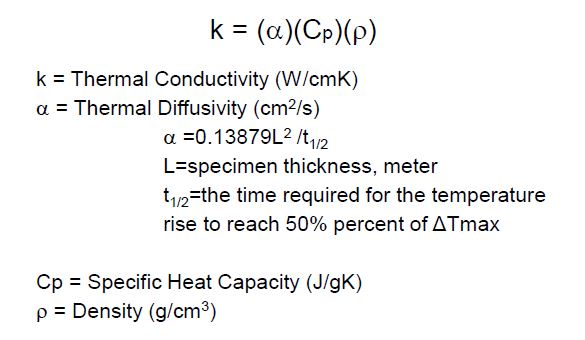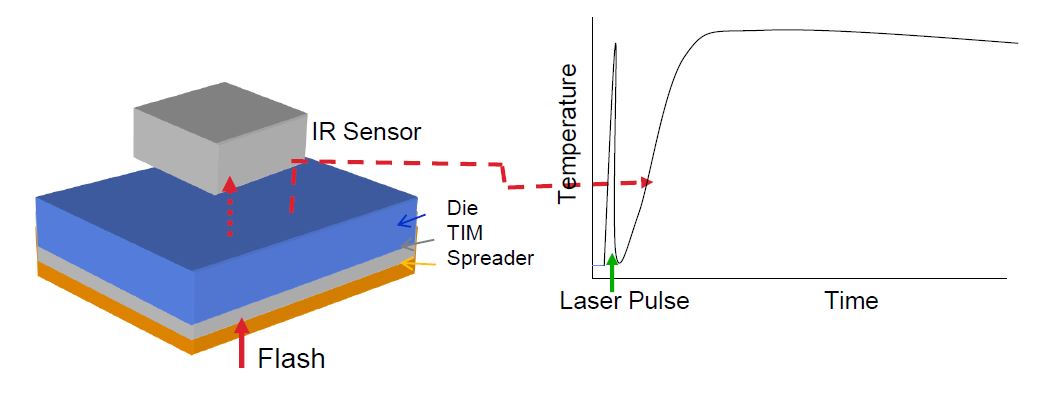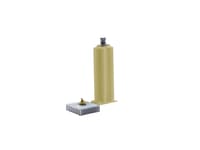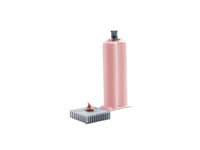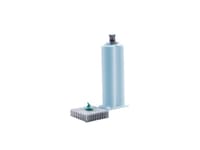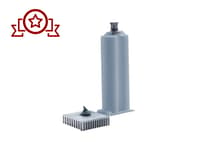Two Part Hybrid
Two part hybrid thermal gel products are two-component, dispensable, thermally conductive gels, which offer long-term reliability and superior softness. The enhanced bonding force between the polymer base and the filler minimizes oil separation issues in storage.
Those two component, dispensable, thermal hybrid gels require very low compression force and can be used for vertical mounting. Prior to curing, the materials maintain good thixotropic characteristics and low viscosity to be easily dispensed. Additionally they show minimal post cure oil bleeding / separation and no pump out and cracking. Their excellent adhesion and high reliability makes them the top choice for Automotive applications. At the same time the ability to cover varying heights and their end properties make them an ideal thermal interface for MM wave wafer antennas and specifically 5G applications.
Two component hybrid thermal gels can be cured in a short time after two-component mixing at room temperature. HLT series thermal gels require curing but very little pressure during installation (5-10psi or the weight of a heatsink is sufficient). You can speed up the process by curing at elevated temperatures (80 -100°C). The high compressibility minimizes thermal resistance at interfaces, making hybrids ideal for low stress applications while maintaining excellent performance during reliability testing. They are generally considered slower due to the mixing stage but they make up for it with their end properties. They exhibit low contact resistance, long term reliability while they are also easy to dispense and rework.
HLT 2000 | Two part Hybrid Thermal Gel
- Yellow + White
- 2.0 Thermal Conductivity
- Cost Effectiveness
- 8 weeks
HLT 1800 | Two part Hybrid Thermal Gel
- Yellow + White
- 1.8 Thermal Conductivity
- Cost effective
- 8 weeks
HLP 2000 | Two part Thermal potting material
- Low Viscosity
- 2.0 Thermal Conductivity
- Room temperature cure
- 12 weeks
HLT 2000LV | Two part Hybrid Thermal Gel
- White + Dark Red
- 2.0 Thermal Conductivity
- Low volatility
- 8 weeks
HLT 3000 | Two part Hybrid Thermal Gel
- Blue + White
- 3.0 Thermal Conductivity
- Stencil Printable
- No longer available
HLT 3500 | Two part Hybrid Thermal Gel
- Blue + White
- 3.5 Thermal Conductivity
- 0.44 Thermal impedance
- 8 weeks
HLT 3500LV | Two part Hybrid Thermal Gel
- Blue + White
- 3.5 Thermal Conductivity
- 0.44 Thermal impedance
- 8 weeks
HLT 7000 | Two part Hybrid Thermal Gel
- Dark Red + Gray
- 7.0 Thermal Conductivity
- High reliability
- 8 weeks
HLT 10000 | Two part Hybrid Thermal Gel
- Dark Gray + Gray
- 10 Thermal Conductivity
- The pinnacle of TIM
- 8 weeks
Product Selector Guide
| Product name | Color | Viscosity (cps) | Hardness (Shore00) | Specific Gravity | Thermal Conductivity (W/m·K) | Thermal Impedance (˚C·in2/W) | Breakdown Voltage (kV/mm) | Cure Schedule 25˚C (hour) | Cure Schedule 100˚C (min) |
|---|---|---|---|---|---|---|---|---|---|
| HLP-2000 | Gray | 6,000 | 55 | 2.2 | 2.0 | - | - | 24 | - |
| HLT 2000 | Yellow + White | 200,000–350,000 | 50 | 2.8 | 2.0 | 0.66 | > 10 | 10 | 30 |
| HLT 2000LV | White + Dark Red | 200,000–400,000 | 35 | 2.8 | 2.0 | 0.60 | - | 16 | 30 |
| HLT 3000 | White + Blue | 100,000-200,000 | 50 | 3.1 | 3.0 | 0.45 | > 10 | 18 | - |
| HLT 3500 | White + Blue | 300,000–450,000 | 40 | 3.2 | 3.5 | 0.44 | > 10 | 12 | 30 |
| HLT 7000* | * | * | * | * | 7.0 | * | 8.5 | * | * |
| HLT 10000* | * | * | * | * | 10.0 | * | - | * | * |
*Since those are top of the line products, we go to certain extends to protect Honeywell\'s IP and competitive advantages. A plethora of information, including additional data, images and samples are available once an NDA is in place. Contact us for more details. (They\'re really really good)
**Typical values for electrical properties on our high end products are: Dielectric constant@1MHz: 9 and Volume resistivity: 1013Ω*cm
**Lower conductivity materials have much lower filler content and therefore have even higher volume resistivity which makes them more insulative.
Frequently Asked Questions
Frequently asked questions about Two Part Hybrids
Are Two component thermal hybrids considered phase change materials?
No, they are not. They are called hybrids and not thermal gels because hybrids (both one and two-component) share ingredients and compounds found in both Thermal Gels and Phase Change Materials. They combine the best of both worlds and use additives found in Phase Change formulations.
This combination allows the HLT series to reach the highest thermal conductivity in the market (10 w/mK) while achieving bond lines suitable for 5G applications. In fact, HLTs are successfully used by the largest 5G manufacturers worldwide.
What are the differences between one-part and two-part hybrid gels?
There isn't much difference in texture and thermal properties. A two-part system requires multiple adapter heads for mixing and cures in 2 hours at room temperature. One-part is generally better for horizontal applications, but two-part hybrid is suitable for both because it cures in place and has better adhesion to the heatsink surface.
However, you always need to trade off between adhesion and reworkability. Even for two-part hybrid, the adhesion is not strong, just slightly higher than one-part. For small devices (consumer electronics), you could also use one-part for both directions.
What is the texture of thermal hybrid gel? Are they adhesives?
They are not like a rubbery elastomer; they remain in gel form and do not perform elastically. When you apply pressure, the gel will spread and thin down. If you remove pressure afterward, it will not bounce back to its original form. Among all TIMs, only gap pads with low TC can recover. This is why, for gap pads, even if you tear them off the heatsink, you can still reconnect and use the same material. For other materials, you need to remove them and apply new material.
Thermal hybrid gel is not designed as a structural adhesive and has a low level of natural tack, which allows the material to adhere mildly to adjacent components. This also helps keep the material in the interface throughout repeated temperature cycling and eliminates pump-out from the interface.
What happens to the material if exposed to temperatures above 35°C? Could this trigger premature curing?
Higher temperatures will speed up oil separation. It will not necessarily trigger premature curing for all thermal gels; it depends. One of the compositions, silicone oil, is not a pure chemical. If it is a curable type of thermal gel, it must contain Si-H, Si-vinyl, and a catalyst. If all three chemicals are added simultaneously to the thermal gel, then heat can trigger the gel to cure.
Are Two-Part Hybrid Gel products cured or not cured?
It is not entirely accurate to use the word “cure.” One-part hybrid gel is fully cross-linked, while two-part gel is not fully cross-linked. It takes 2 hours for a two-part hybrid to cure. The process is: you first dispense the gel onto the surface, then apply pressure, which will cause it to spread and thin down, and then leave the gel to cure in place.
What are the applicable temperature range and pressure for hybrid gel?
Thermal hybrid gel products are silicone-based. All silicone-based thermal products can be used up to 200 °C.
Hybrid gels need less than 10 psi to reach a Bond Line Thickness (BLT) of 0.1mm – 1.0mm; PCMs, however, require higher pressure and are suitable for 0.03-0.05 mm applications.
Does a temperature range of 0°C-35°C impact the material’s viscosity when exposed?
Temperature range will not significantly impact the viscosity of thermal gel. The composition of thermal gel is silicone oil plus thermal filler. Neither silicone oil nor thermal filler is sensitive to temperature.
What are some common applications for Two component hybrid thermal gels?
Typical Two-part hybrid gap filler applications include:
- Consumer electronics
- Telecommunications equipment
- Automotive electronics
- Memory and power modules
Learn More
Two-part Hybrids
Key Performance Benefits For Choosing Thermal Hybrid Gel
Hybrid is a substance between liquid and solid. Hybrid thermal gel, prepared as a silicone polymer, with low molecular siloxane, and mixed with high thermal conductivity particles (such as alumina, aluminum nitride powder, etc.). As thermal conductive liquid gap fillers, hybrid gels offer good dispensing and thixotropy properties for automated assembly processes. They not only have the benefits of conforming to complex shapes and strong material cohesion, and also good long-term thermal stability. Caplinq provides pre-cured hybrid and two-part hybrid products that require mixing and curing steps.
The key benefits of choosing thermal hybrid gel products are summarized:
| Reliability | Compared to thermal grease, the main difference is that thermal hybrid does not present oil separation issues while in storage. Compared to gap pads, there is no pump-out or cracking risk. The Hybrid can be torn off and reused. |
|---|---|
| Compressibility | High compressibility minimizes thermal resistance at interfaces, while maintaining excellent performance during reliability testing. Thanks to the ultra-low modulus, the gap filler creates minimal stress on components during the assembly process, which makes it applicable for most of the fragile and delicate devices. |
| Flexibility | Hybrid gels offer infinite thickness and shape options, and are able to conform to intricate topographies, including multi-level surfaces. They are a single solution for multiple applications. Rheological characteristics could also be adjusted to suit different requirements. |
| Productivity | Prior to curing, the material maintains good thixotropic characteristics and low viscosity to be easily dispensed. The material could be applied directly to the target surface by manual or automatic dispensing, which improve productivity and precisely control the application process with minimal wastage. |
Two-Part Hybrid Gel V.S. One-Part Hybrid Gel
The HT series is one-part hybrid gel, which is already fully cross-linked before being applied. It could save time in assembly process and has longer shelf life. The HLT series products are two-component gels that can be cured in short-time after two-component mixing at room temperature. For details process handling guide, please refer to HLT Products Application Note and HT Products Application Note products are cured in place, thus have better adhesion to components and are suitable for both horizontal and vertical applications. In total, the two series products share similar thermal and electrical properties.
| Compared Properties | One-Part Thermal Hybrid Gel | Two-Part Thermal Gel |
| Dispensing Rate | Medium | Quick |
| Curing Needed | No Need | Yes, 2 hours @Room Temperature |
| Assembly Stability | Horizontal Assembly Preferred | Horizonal & Vertical Assembly Both Applicable |
| Thermal Conductivity | A Wide Range Up To 11 W/mK | A Wide Range Up To 11 W/mK |
| Assembly Pressure Required | Low, < 10psi | Low, < 10psi |
| Work Life | Long | Medium |
| Shelf Life | 12 months @RT, <65%RH | 6 months @RT, <65%RH |
| Reworkability | Good | Medium |
Impact of Temperature on Thermal Gel Viscosity and Stability
Does wide temperature exposure affect the viscosity of thermal gels?
In general, temperature variation does not significantly affect the viscosity of thermal gels in the short term. This is because thermal gels are composed mainly of:
Silicone oil, which has relatively stable rheological properties over a broad temperature range
Thermally conductive fillers, which are not sensitive to temperature
As such, the gel maintains its general consistency and processability even under varying ambient conditions. However, the real concern at elevated temperatures is not viscosity—but rather oil separation.
Why is Temperature Control Important for Thermal Gels?
While thermal gels remain stable under moderate temperature changes, prolonged exposure to elevated temperatures (e.g., >35°C) can accelerate oil bleed or phase separation. This is due to the relatively large filler particle size in gels compared to PCMs, which:
Increases the risk of filler settling
Promotes silicone oil migration when stored or used outside the recommended range
Thermal Hybrid Gel Property Measurement
Thermal impedance testing
Two part hybrid thermal gels exhibit exquisite thermal characteristics with Thermal conductivity reaching 10 w/mK. But how do those thermal properties change with pressure and bond line thickness?
To identify this we used a TI tester to test thermal impedance under ASTM D5470 requirements. The temperature was kept steady at ~75°C and the sample (a 1" diameter circle) was tested in a pressure ramp starting from 5 and resulting to 50psi. At this point we need to reiterate that we focus on TI, as a more valuable "real life" value and that our properties are never overstated. So what you see in the Technical data sheets is what you get.
)(5).png)
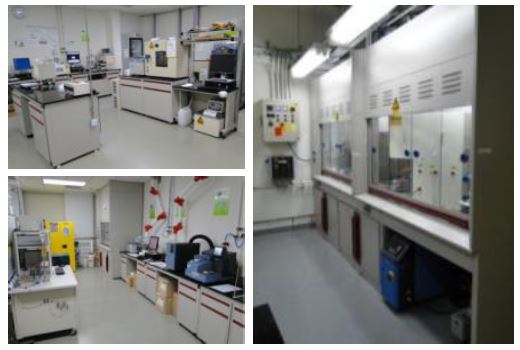 | Effects of pressure on BLT & TIAs expected, when applying pressure, the bond line thickness drops significantly while at the same time thermal impedance drops too. Those properties tend to stabilize halfway but there's room for improvement for both BLT and TI, which maximize (technically minimize) their values at 50 psi. It is worth pointing out that HLT10000 is starting with very low Bond line thickness and minimal Thermal impedance that both slightly improve with pressure. It is remarkable that the presureless BLT starts at extremely low BLT while at the same time having an unrivaled TI. This makes HLT10000 the most High end thermal interface material in the market with out of the box properties that are second to none. |
Thermal Properties Test Method
Thermal impedance test method: Cut bar
All of our product properties are tested based on strict and regulated test method standards such as the ASTM. The test method always accompanies the product properties. We try to undershoot rather than overshoot the product capabilities so that you always get at least the advertised properties (and usually much better than that). We pride ourselves in providing "spot on" stated properties.
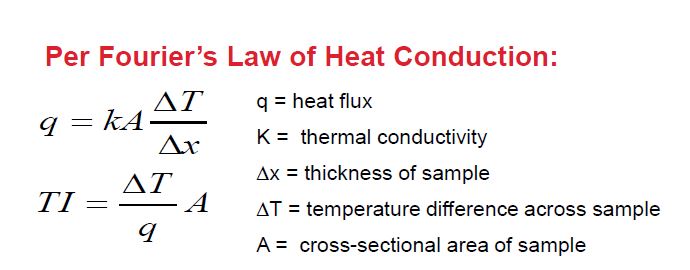
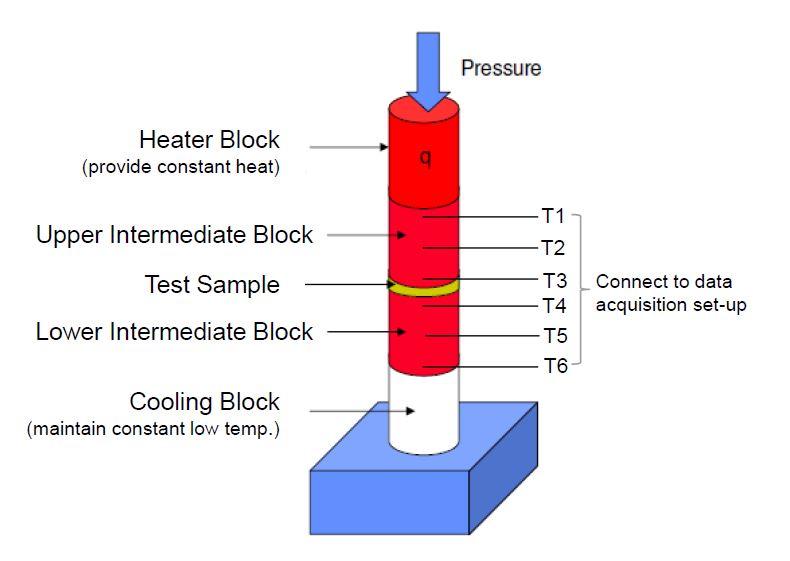
Thermal conductivity is an easy way to categorize products and it is true that this is the leading property in our product nomenclature. At the end of the day though, Thermal impedance is what makes the real difference. That\'s why most of our technical discussions revolve around these values. In order to test it we have implemented various methodologies such as the Cut bar method that is demonstrated in this image.
This methodology is based on ASTM D5470 (at the time this content was written) and is a destructive, one time test with fast and immediate results. One of the most common methodologies that we use for Thermal impedance.
Thermal impedance test method: Laser Flash
Another test, suitable for accelerated life testing, is the Laser flash method. With ASTM 1461 (current) we measure the thermal impedance between Si, Ni plated Cu surfaces.This method includes the CTE mismatch and the actual surface finish.
Laser flash takes thermal diffusivity into account and the calculation follows the logic in the image. Typical coupons used are:
- Ni plated Copper -0.5”X0.5”X0.03”
- Si - 0.5”X0.5”X0.02”
Please note that these methodologies are not strictly limited to one part hybrid thermal gels but they also extend to out entire thermal interface product line, when applicable.
